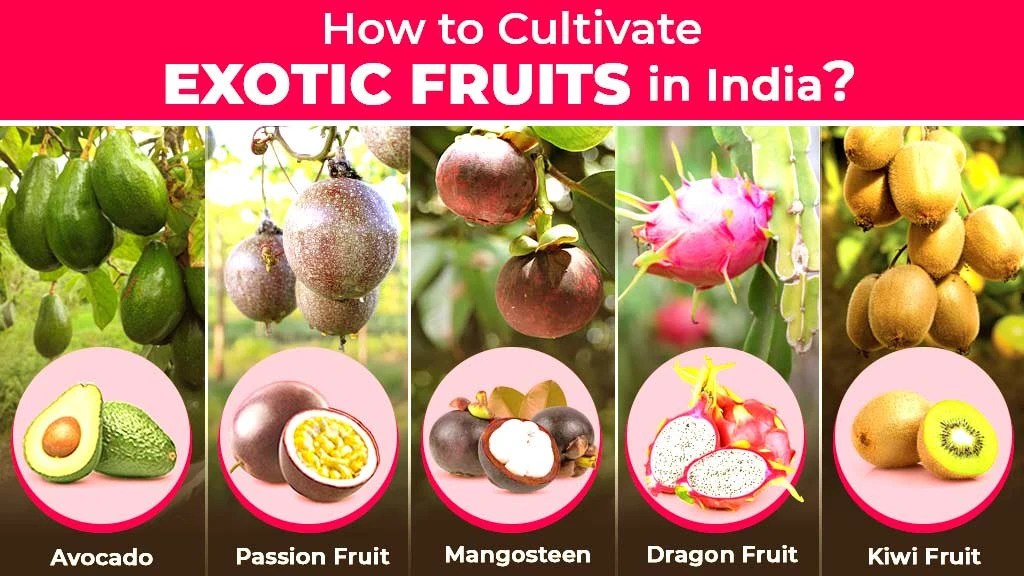How to Cultivate Exotic Fruits? Scope & Popular Exotic Fruits

Exotic fruits are high-value commodities that can fetch more money for farmers. India is witnessing increasing demand for these fruits in urban and semi-urban areas. This is mainly because of their excellent taste and health benefits. If you want to get a slice of the big exotic fruit market, go through this blog and get an understanding of these fruits and their cultivation.
Table of Contents
- What does Exotic Fruits Mean?
- What is the Scope of Growing Exotic Fruits in India?
- What are the Popular Exotic Fruits in India?
- What to Consider When Growing Exotic Fruits in India?
What does Exotic Fruits Mean?
Consumers have been showing interest in the term ‘exotic’, which implies something foreign, unusual and mysteriously different. Exotic fruits are not native and include a wide variety of tropical and subtropical fruits. They are popular for their unique taste and medicinal value. India has a big market for exotic fruits because of the growing urban class and exposure to global cultures. An increasing population of health-conscious individuals is inclining towards exotic fruits and vegetables. Growing exotic fruits in India can ensure high financial returns due to their high market value.
What is the Scope of Growing Exotic Fruits in India?
The Indian consumer market is growing interested in fruit consumption, which is trending towards healthy lifestyles and plant-based diets. Indian consumers consumed 721,493 tonnes of imported fruits and vegetables in 2021. It was worth more than ₹ 19,700 crores in 2022. The annual import of exotic fruits has been increasing over the years. In 2022, fresh fruit imports to India were estimated to be 4,00,000 tonnes, which was worth around ₹ 40 billion.
Exotic fruits have a higher price as they demand a premium over local fruits. An imported avocado fruit can be priced anywhere between INR 200 and INR 400. Dragon fruit is a superfood that comes to India, mainly from South-East Asia. India has a large marginal and wasteland area that can be used to grow some low input and demanding exotic fruits. A number of farmers from Karnataka, Kerala and Himachal Pradesh are cultivating exotic fruits to meet the rising demand and earn high returns.
What are the Popular Exotic Fruits in India?

Avocado
Avocado (Persea americana), also called butter fruit, comes from the Lauraceae family. It is native to tropical America, with its origins tracing back to Central America and Mexico. This fruit was introduced to India from Sri Lanka in the 20th century. It is grown on a small scale in Karnataka, Maharashtra, Kerala, Sikkim and Tamil Nadu. Avocado is low in carbohydrates but rich in fat (around 30%) and proteins (around 4%). This fruit is usually consumed in salads and sandwich filling. Avocado cultivation is prevalent in tropical or semitropical areas with some rainfall in the summer season.
Passion Fruit
Passion fruit (Passiflora spp.) has tasty, flavoured juice. This is why it is a high-value and export-oriented fruit. It originated in Brazil and is commonly grown in Australia, Indonesia, New Zealand, Kenya and South Africa. In India, passion fruit is cultivated in Kodaikanal, Coorg, Kerala, Malabar, Niligiri Hills and Himachal Pradesh. Its juice is a rich source of Vitamin C and A. It is used to make refreshing drinks and jam and flavour ice cream. The commercial propagation of passion fruit is done through seed and cuttings.
Mangosteen
Mangosteen (Garcina mangostana) comes from the Clusiaceae family and grows well in humid, warm and equatorial climates. This evergreen tree is common in tropical countries of Asia, including Malaysia, Thailand, Philippines, Vietnam and India. In India, it grows in tropical areas with decent rainfall and high humidity, like Kerala, Tamil Nadu and Nilgiri Hills. Mangosteen is a juicy fruit with a tangy and sweet taste. When ripe, it has a deep reddish-purple rind, which is inedible. The fragrant edible flesh is endocarp. This exotic fruit is popular for its antifungal, antibacterial and antioxidant properties.
Dragon Fruit
Dragon fruit (Pitaya hylocereus) is cultivated across South America, North America, Australasia and Asia. This cactus fruit is also popular as pitaya or strawberry pear. It comes in two types: sour and sweet. Its different colour varieties include Costa Rican, yellow and red dragon. Its fragrance is delicious, and the fruit can be used to make wine or juice. Its flowers find use in tea. Dragon fruit has bright purplish to pink pigment, which is used to colour several value-added products on a commercial scale, including flavoured milk and yoghurt, ice cream, squash, and fermented beverages.
Kiwi Fruit
Kiwi (Actinidia deliciosa) comes from the Actinidiaceae family. It is popular as ‘the horticultural wonder of New Zealand’ and ‘China’s miracle fruit’. In India, kiwi is cultivated in Kerala, Arunachal Pradesh, Jammu & Kashmir and Himachal Pradesh. It can grow in regions with 700 to 800 chilling hours, where the temperature is at or below 70°C. This fruit has a pleasant aroma and refreshing, delicate flavour and is rich in carbohydrates, vitamins, sugars and minerals. The main cultivars of kiwi in India are Matua (Male), Tomuri, Bruno (Female), Abbott, Hayward, Monty and Allison. Kiwi is ideally planted in January while it ripens between Oct-Dec based on climate and variety. Its commercial propagation is through cutting and tongue grafting during Dec-Jan (dormant season).
Other popular exotic fruits in India are:
- Rambutan (Nephelium lappaceum)
- Pulasan (Nephelium mutabile)
- Longan (Dimocarpus longan Lour.)
- Durian (Durio zibethinus)
- Loquat (Eriobotrya japonica Lindl.)
What to Consider When Growing Exotic Fruits in India?
Climate
Exotic fruits have particular climate requirements. Research and ensure optimal climatic conditions, including sunlight exposure, humidity and temperature range. If the need arises, you can consider greenhouse settings or microclimates in the garden.
Soil
Exotic fruits can demand varying soil types. They prefer fertile and well-drained soil. Based on the preference of the fruit, choose alkaline or acidic soil. You may need to conduct regular soil testing and modifications.
Irrigation
It is important to understand the watering requirements of a particular exotic fruit. Some fruits may demand dry conditions, while others may need consistent moisture. Ensure to prevent root rot by preventing waterlogging.
Pest & Disease Management
Like other fruits, exotic types are also at risk of damage from pests and diseases. It is better to research common pests and diseases that can harm the chosen fruit. Get training on the preventive and control measures before cultivation.
Harvesting & Storage
It is important to harvest the crop at the correct time for a healthy and high yield. Every fruit variety achieves ripeness and peak flavour at an optimal time. Make sure to harvest the fruit during the ideal harvesting season. Also, the shelf life of harvested fruits should be improved with proper storage conditions that offer suitable humidity and temperature levels.
With the increasing urban population and health consciousness among consumers, the demand for exotic fruits is gradually increasing in India. The business of exotic fruits can meet the new and rising demand for these high-value fruits. Exotic fruits fetch high prices and thus are an excellent source of good money. Follow the guidelines revealed in this blog and start your exotic fruit farming business now.


Related Blogs












